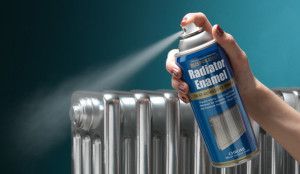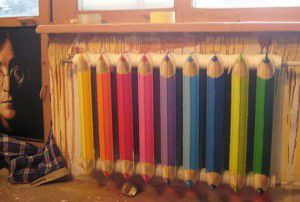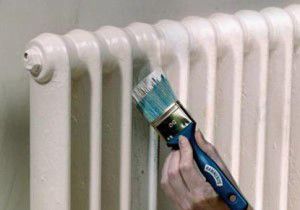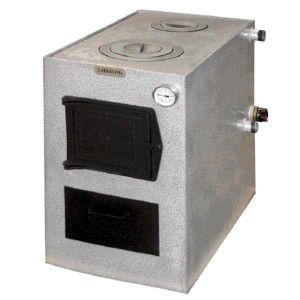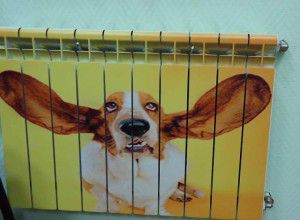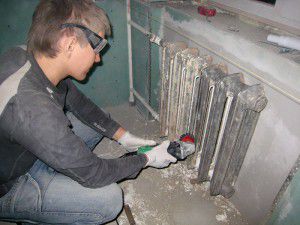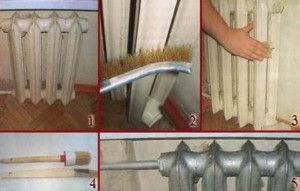Not always the appearance of radiators or heating pipes fits the exterior design of the room. To solve this problem, you can hide them, or change the color cast. The latter option is much simpler. That is why paint for batteries, pipes and heating radiators has become popular: a review, reviews, comparisons of different types will help determine the choice.
Paint requirements for heating
First you need to decide on the main operational data. Any paint for odorless radiators must have certain qualities, which are determined by the parameters of the system.
The main requirement is safety for humans. Those. regardless of external factors, the paint layer should not emit harmful elements. In addition, the possibility of applying to a steel surface is taken into account. In some cases, for this it is necessary to apply an intermediate base for better shrinkage of the protective layer. These qualities have acrylic paint for radiators.
Manufacturers often indicate capacitance characteristics of paint products. In particular - the possibility of applying to heating elements. In addition, the following paint requirements for hot radiators should be followed:
- Maximum exposure temperature without loss of appearance and shade. It can reach + 600 ° C. But for heating, models with a critical thermal effect of + 450 ° C are quite suitable;
- Abrasion resistance. After final drying, the paint for hot heating pipes should not be thinned with minor mechanical influences;
- Standard resistance to detergents during heating. Those. it is undesirable to acquire those compounds that may be destroyed during the cleaning of the room.
Is it difficult in practice to independently change the color of the radiator and pipes, in which cases is it necessary? Most often, colored paint for heating radiators is required to restore the appearance after prolonged use. In this case, it is necessary to choose the right type of paint, which may differ in composition and method of application.
You can change the shade of the paintwork using pigment. But it must also be designed for the heating system.
Types of paint
Alas, a large assortment of paint products is more a problem than help in choosing. Often there are annoying mistakes that entail negative reviews about paint for radiators. In order to avoid this, it is recommended that you familiarize yourself with the types of paint coatings before purchasing.
Acrylic paints for heating
For the production of these enamels, acrylic resin is used in combination with a number of organic fillers. This is an ideal paint for odorless heating radiators at relatively low exposure temperatures - up to + 90 ° С.
After application to a metal surface, it acquires a characteristic glossy sheen. It can persist for 3-4 heating seasons. Gradually, it will disappear, but the original shade will remain. In addition, acrylic-based paint for plastic heating pipes is best suited for this fabrication material. It does not contain aggressive solvents characteristic of other compounds.
The features of acrylic compositions include:
- Long service life. Subject to application technology, it can be 25-30 years;
- Does not change its properties under the influence of direct sunlight, in particular - IR radiation;
- Choice of painting technology - roller, brush or spray.
To create a durable layer, paint for Dufa heating radiators is recommended. Despite the relatively high cost, it is guaranteed to retain its properties even under extreme temperature conditions of heating. The average cost of Dufa Glanz is 2.5 liters. is 455 rubles.
The shelf life of paint for Dufa heating radiators is 12 months. In this case, the temperature should not be less than + 5 ° C. Otherwise, it will lose its properties.
Alkyd paints for heating
Ambiguous reviews of paint for alkyd-based heating radiators have become a major factor in their unpopularity. The main complaint is a pungent odor that lasts 2-3 days after application to the surface of a radiator or battery.
The basis for the manufacture of this type of paint is alkyd resin, obtained by cooking vegetable oil with alcohol or organic acids. The result is a thick composition, which after application is not afraid of exposure to high temperatures, water and many types of chemical compounds.
It refers to the types of paints for hot radiators. However, along with this opportunity, you need to be prepared that before the final cooling of the protective layer, the specific smell will intensify. This is due to the composition of the coating. But at the same time, if it is necessary to apply color paint for heating radiators, an alkyd would be the best option.
Specific properties of alkyd compounds:
- High threshold of heat resistance;
- At the initial stage, slight burnout is possible, and as a result - a change in shade;
- Easy to level surface. Painting is carried out using a brush or roller.
When choosing, you should pay attention to the composition and consistency. It is best to choose a ready-to-use paint for hot heating pipes in a liquid state. If you buy pasty formulations, you will need to dilute them with solvents, which is not always practical.
Alkyd paints can be oil or enamel. The latter is best not to be used as paints for radiators due to the smell and fragility of the layer.
Heat-resistant paints for heating
Analyzing most reviews of paint for radiators, it can be noted that not all of the above types are suitable for solving specific problems. In particular, paint for Tikkuril heating radiators is not used to protect solid fuel heating boilers, in which the surface temperature may be above + 100 ° C.
If it is not possible to use acrylic paint for radiators, alternatives can be found. These include powder coating technology. It consists in the use of special compounds, which after a short-term thermal exposure can withstand a significant increase in temperature up to + 600 ° C. However, in practice, this will require special equipment.
For home use, you will need a special heat-resistant paint for water-based heating radiators. It differs from the traditional ones not only in composition, but also in operational qualities:
- The presence of metallic powder from aluminum or zinc. The latter can not be used indoors. Designed for even distribution of heat on the paint surface, prevents premature aging and bloating;
- Addition of silicone-epoxy or silicone-acrylic components to the composition;
- Possible difficulties when removing the paint layer;
- The use of such paint for plastic heating pipes is unacceptable.It adversely affects polymers.
One of the best types of heat-resistant paint is Mipatherm 600. It can withstand long-term thermal effects up to + 600 ° C. However, the cost of one liter is the main factor in its mass unpopularity. Currently, the price of this paint for odorless heating radiators is 680 rubles / liter.
Before the painting process, it is best to turn off the heating system. Despite the assurances of manufacturers of protective enamels, the best result is achieved when applied to a metal surface with normal room temperature.
Technology for painting radiators, pipes and batteries
After choosing the optimal composition for forming a protective surface, you can proceed directly to painting. However, before that, it is necessary to read the operating instructions and take into account all the nuances. So, paints for water-based heating radiators have a rather long final hardening period. Therefore, they are recommended not to be used during the heating season.
Before performing this procedure, it is advisable to familiarize yourself with the recommendations from professionals. They are as follows:
- Work is best done in the summer. At this time, normal ventilation can be provided to ventilate the room without lowering the temperature in it. The same applies to odorless paint for heating radiators, since it requires the observance of certain conditions for high-quality drying;
- Protective equipment must be used - a respirator, work clothes and waterproof gloves;
- It is not recommended to apply paint to hot heating batteries;
- You can change the shade of the composition only with the help of special pigments, which should also be heat-resistant. It is best to purchase paint and dye from the same manufacturer.
Given these factors, you can proceed directly to the painting procedure. It is worth remembering that the final drying time for paint for odorless radiators is often less than that of alkyd ones. It is best to paint radiators prior to installation.
Preparatory stage
First you need to thoroughly clean the surface of the pipe or battery. To do this, you can use a brush for metal or a grinding machine with a special nozzle. If the initial layer of acrylic paint on the battery is of high quality, special solvents should be used.
For these purposes, the so-called “washes” are suitable - SP6, B52 or branded solvents for paints of Tikkuril heating radiators. Typically, to bring them you should do the following:
- Clean the surface of the pipe or radiator as much as possible from the old paint layer. At the same time, the integrity of the structure must not be affected or the thickness reduced.
- Apply solvent and wait about 5 minutes.
- Repeat mechanical cleaning.
Thus, the surface of the heating element must be completely freed from the old paint coat for water-based or enamel radiators.
Cleaning plastic heating pipes from paint should only be carried out chemically. Mechanical stress can lead to their deformation.
Heating system painting
Before applying acrylic paint to the heating battery, a bonding base should be prepared. For this, primers are used, which are intended for better adhesion of the paintwork composition and the metal surface.
Almost all types of primers are not designed for painting for hot heating pipes. That is why you should first turn off the system, and then proceed to applying the protective layer. To do this, you need to follow these steps:
- Protect floors and walls from possible ink. This is especially true for the use of a spray gun as the main painting tool;
- After applying the first coat, wait a while to dry it first. This is one of the recommendations of manufacturers of Dufa paint for heating radiators.
On this, the coloring process can be considered completed. Some reviews of paint for heating radiators indicate a change in color during the drying process of the protective layer. This is characteristic of all paints and varnishes.
To remove the powder coating layer, the mechanical method should be used in combination with special solvents.
Paint prices for heating and customer reviews
One of the main consumer qualities for any product is price. It directly depends on the characteristics of colored paint for heating radiators, as well as its manufacturer. Currently, there are a number of companies that specialize in the production of paint for heating. These include Dufa, Tikkurila, Hansa.
Most domestic manufacturers offer products designed for extremely high temperatures. It is used only in industry and manufacturing processes. Therefore, for painting heating elements using products of foreign brands.
| Paint | Cost, rub. |
| Dufa Glanz, 2.5 L | 455 |
| TIKKURILA Empire 0.9 L | 960 |
| Hansa Aerosol, 16 colors, 0.4 L | 817 |
However, in addition to the cost, it is recommended to read the real reviews about paint for heating radiators:
- Old radiators have long lost their appearance. Paint peeling off in places, partially fell off altogether. Therefore, we decided to do the appearance prevention. To do this, chose the expensive paint Tikkurila Empire. Honestly, the price is paying off - after the first season, pipes and radiators are like new;
- Hansa aerosol was purchased to upgrade the appearance of aluminum radiators. Alas, they overlooked that he had the wrong shade of white - 9016. With our radiators, he turned out to be RAL. Upon closer examination, the difference is visible;
- Out of ignorance and natural greed, I purchased paint for batteries from a dubious manufacturer. Alas, after several days of torment I had to buy much more expensive, but normal. - Dufa. And literally half a day of work was enough to make sure that it was better to pay a good price and get at least a wonderful result.
What paint is recommended for specific radiators or heating pipes? It all depends on their fabrication material and system operating modes. Therefore, it is recommended that you first read the instructions from the manufacturer, and then select the best option.
In the video material, a specialist will advise which paint to choose and what to pay attention to:
